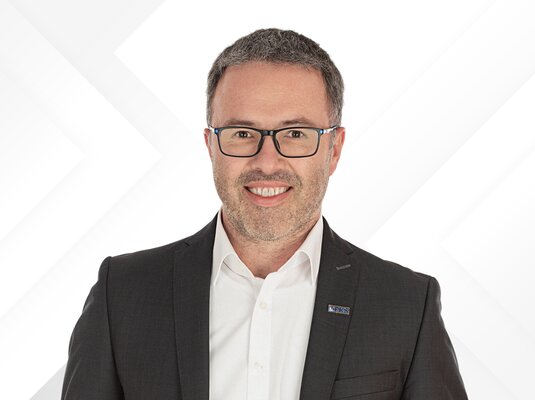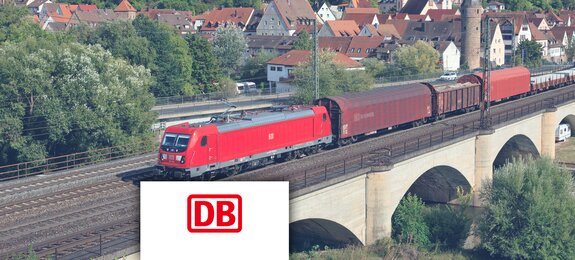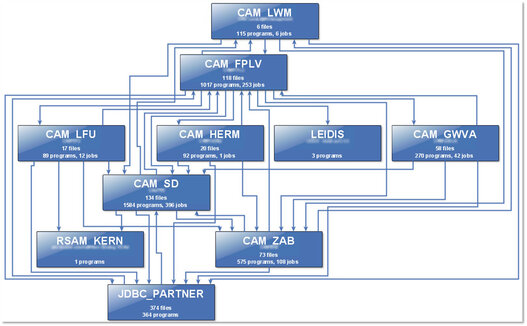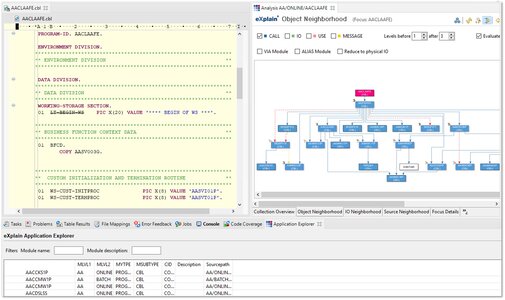Cleaning up and decomposing the application helped us to create a sustainable migration plan and drive modernization.
Tim Engeleiter Technical Architect Mainframe ModernizationDB Systel GmbHThe company
DB Systel GmbH, based in Frankfurt am Main, is a wholly owned subsidiary of DB AG and digital partner for all Group companies. Systematic digitalization is the key to "Strong Rail". DB Systel is working together with all of Deutsche Bahn's business units and across the entire rail network to digitalize business processes and create digital, holistic solutions in order to create excellent customer experiences with strong customer benefits. To this end, DB Systel has developed a comprehensive range of services that meet the highest IT standards and requirements. Effective and efficient solutions are implemented on the basis of technological foundations such as platforms and services and innovative topics such as the Internet of Things and artificial intelligence. In addition, sustainability in and through digitalization is becoming increasingly important as part of DB's overall orientation. As a long-term partner, DB Systel contributes in-depth rail and IT expertise and acts in a vendor-neutral manner for the common goal. Around 6,000 people are currently employed at the main sites in Frankfurt, Berlin and Erfurt.
Declining importance of the mainframe platform
The mainframe has no longer been of strategic importance in the DB Group for many years, which is why the workload is continuously decreasing. At the beginning of the 2020s, freight transport was the only remaining business area with business-critical applications based on COBOL/Db2 or ADABAS/Natural. The following decisions were made to move these applications away from the mainframe:
The ADABAS/NATURAL applications will be replaced by automated code transformation and then modernized, as their business processes will still be required in their current form in the future.
Some of the COBOL/Db2 applications do not adequately map business processes and are therefore being successively replaced by new applications. DB Systel was therefore faced with the challenge of quickly removing the applications from the host (re-platforming) and transferring them to a future-oriented IT architecture. This goal is to be achieved by gradually migrating the applications to the DB Enterprise Cloud, which is based on Amazon Web Services. The OpenText Enterprise Server (formerly Micro Focus) will be used as the tool for this. This step not only enables a modern IT architecture, but also significant savings in operating costs through the use of cloud-based infrastructure. The project is scheduled to run for around 24 months.
The pressing questions were obvious
DB Systel found answers to these questions in cooperation with PKS. The code analysis tool eXplain was also used and helped to achieve the optimum project result.

Project goal: Lift & Shift
An important component in this process was the use of the Micro Focus Enterprise Server product. This tool enables a seamless migration, while the proven technologies COBOL, JCL, CICS and IBM MQ were largely retained. This migration to a Linux platform did not require any functional changes, unless these were unavoidable for technical or regulatory reasons, and the database management was also changed in parallel with the migration of the applications: the Db2 z/OS database system was replaced by a Linux DB server with Db2 LUW. At the same time, the current job control system, IBM TWS (Tivoli Workload Scheduler), was replaced by Automic Automation (UC4) to ensure compatibility with cloud technologies.
Non-cloud-capable communication protocols were also replaced. To maximize the efficiency of the new system, the build, deployment and test processes as well as the infrastructure setup were also automated using Gitlab-CI. This required a corresponding adaptation of the release processes in order to optimally align them with the new system. The last, but equally important step of this project was the establishment of an organizational structure for the operation of the new environment in the DB Enterprise Cloud. With this structure, DB Cargo can fully exploit the advantages of cloud technology and is ideally equipped for future challenges.
Central guiding principle: Reducing complexity reduces project risks
In order to achieve an optimal end result and ensure the success of the project, 4 guiding principles were defined, which the project approach should be based on:
Bereinigung des Quellcodes, Db2, JCL & Co.
The analysis of the existing CAM applications revealed a clean-up factor of 22 & for unused code. This dead code was removed BEFORE re-platforming. Another finding from the eXplain analysis was that 84% of the code is (generated) access modules!
Therefore, the code was also cleaned of Db2 tables without access modules.
In addition, job chains and JCL were streamlined, resulting in a reduction of around 60% in this area.
Replacing proprietary technologies
The non-web-based client applications were previously connected via a proprietary protocol, which did not meet the current security requirements in the cloud environment (e.g. no encryption-in-transit). It was decided to switch to web services and connect to the central ActiveDirectory using OAUTH.
Prefer the use of native technologies
IBM CICS Transaction Gateway (CTG) was only used for >20 transactions and was therefore replaced by web services.
Files are currently sent via IBM ConnectDirect (C:D) and FTPS and will be completely converted to SFTP during the migration.
Switch to native technologies for SQL export and preparation.
Rethinking processes
There are numerous processes for requesting Db2 changes, CICS transactions etc.. However, this leads to a lot of manual work and many Excel lists in different storage locations. These processes should be automated as far as possible with Gitlab-CI.
The Jenkins delivery process was previously very complex and is undergoing a complete redesign in Gitlab-CI.
The use of eXplain in the re-platforming project not only brings immediate benefits, but also ensures long-term benefits that extend beyond the end of the project.
Automation of the analysis processes: Simulating the new environment
Supporting development: Aggregate knowledge
The transparency and clarity of relationships, which are often lost due to the lack of prior knowledge, is significantly improved through the use of eXplain. The tool makes a significant contribution to supporting the future distribution of the application, especially through its clustering feature. eXplain serves as a central "place of truth" by aggregating information that was previously only scattered in various Excel documents, CSV files and similar sources and presenting it in a clear way. eXplain also offers the possibility of adding runtime information to show which modules are actually being used. This gives users a clear picture of the real usage of the application, which is invaluable in the further development and improvement of the system.
eXplain is seamlessly integrated into the DevOps toolchain and helps to ensure that further maintenance work can be carried out as cleanly, controlled and error-free as possible after re-platforming.
Summary
The re-platforming approach was the ideal solution for the initial situation of the CAM application. This made it possible to use the transition period until the new applications were implemented to continue operating the existing CAM system in the set railroad cloud infrastructure and thus save costs for the mainframe platform, which was only used selectively.
eXplain has also shown that the aspects of clean-up and optimization should also be used during re-platforming and their potential exploited in order to make subsequent operation as simple, efficient, stable and high-performance as possible. eXplain plays a central role in the project itself and in the time afterwards.
The benefits of working with PKS and using eXplain:

The approach and cooperation in the joint project team followed the procedure proposed by PKS for the modernization: inventory and clean-up of the existing system, cutting the application into sub-areas, step-by-step modernization through to the go-live of individual applications. With measurable progress at all times and on time and on budget, supported by the use of the PKS analysis tool eXplain.
Bernd Butscher Head of Enterprise Software TransformationPKS Software GmbHTools and procedures
- eXplain - The mastermind for IBM applications
- Software Clean-Up
- Development partnership with PKS
Contact
PKS Software GmbH
Georgstraße 15
DE-88214 Ravensburg
Tel: + 49 751 56140-0
Mail: [email protected]


